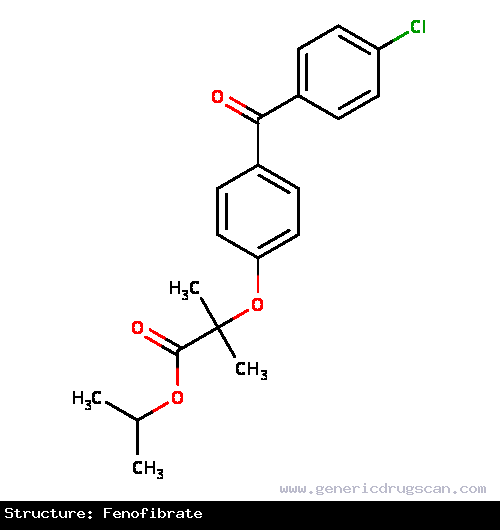Fenofibrate Drug: Indication, Dosage, Precaution, Side Effect , Storage, Category Type and corresponding Brands - www.genericdrugscan.com
Fenofibrate
Drug Status in USA : ApprovedDrug Status in Canada : Approved
pronunciation
pronounced as (fen oh fye' brate)
Why is this medication prescribed?
Fenofibrate is used with a low-fat diet, exercise, and sometimes with other medications to reduce the amounts of fatty substances such as cholesterol and triglycerides in the blood and to increase the amount of HDL (high-density lipoprotein; a type of fatty substance that decreases the risk of heart disease) in the blood. Build-up of cholesterol and fats along the walls of the arteries (a process known as atherosclerosis) decreases the blood flow and, therefore, the oxygen supply to the heart, brain, and other parts of the body. This increases the risk of heart disease, angina (chest pain), strokes, and heart attacks. Although fenofibrate decreases the levels of fatty substances in the blood, it has not been shown to decrease the risk of heart attacks or strokes. Fenofibrate is in a class of medications called antilipemic agents. It works by speeding the natural processes that remove cholesterol from the body.
How should this medicine be used?
Fenofibrate comes as a capsule, a delayed-release (long-acting) capsule, and a tablet to take by mouth. It is usually taken once a day. Some fenofibrate products (Fenoglide, Lipofen, and Lofibra) should be taken with a meal. Other brands (Antara, Fibricor, Tricor, Triglide, and Trilipix) may be taken with or without food. Ask your doctor or pharmacist if you do not know if you should take your medication with food. Follow the directions on your prescription label carefully, and ask your doctor or pharmacist to explain any part you do not understand. Take fenofibrate exactly as directed. Do not take more or less of it or take it more often than prescribed by your doctor.
Your doctor will probably start you on an average dose of fenofibrate and may increase or decrease your dose depending on the results of laboratory tests that you will take to measure the amount of fatty substances in your blood. Your doctor may tell you to stop taking fenofibrate if your test results do not show improvement after 2 months.
If you are taking Trilipix tablets, swallow the tablets whole; do not split, chew, or crush them.
If you are taking Triglide tablets, do not use any tablets that are chipped or broken.
Fenofibrate will help decrease the amount of fatty substances in your blood only as long as you continue to take it. Continue to take fenofibrate even if you feel well. Do not stop taking fenofibrate without talking to your doctor.
What are the precautions to be followed?
Before taking fenofibrate,- tell your doctor and pharmacist if you are allergic to any fenofibrate products, any other medications, or any of the ingredients in the fenofibrate product you are taking. Ask your pharmacist for a list of the ingredients.
- tell your doctor and pharmacist what prescription and nonprescription medications, vitamins, nutritional supplements, or herbal products you are taking or plan to take. Be sure to mention any of the following: anticoagulants ('blood thinners') such as warfarin (Coumadin); colchicine (Colcrys, in Col-Probenecid); diuretics ('water pills'); beta blockers such as atenolol (Tenormin), labetalol (Normodyne), metoprolol (Lopressor, Toprol XL), nadolol (Corgard), and propranolol (Inderal); HMG-CoA reductase inhibitors (cholesterol-lowering agents) such as atorvastatin (Lipitor), lovastatin (Mevacor), pravastatin (Pravachol), rosuvastatin (Crestor), and simvastatin (Zocor); hormone replacement therapy; hormonal contraceptives (birth control pills, patches, implants, rings, and injections); and immunosuppressants such as cyclosporine (Sandimmune, Neoral) and tacrolimus (Prograf). Your doctor may need to change the doses of your medications or monitor you carefully for side effects.
- if you are taking a bile acid resin such as cholestyramine (Questran), colesevelam (WelChol), or colestipol (Colestid), take it 1 hour after or 4-6 hours before you take fenofibrate.
- tell your doctor if you have or have ever had kidney, liver, or gallbladder disease. Your doctor will probably tell you not to take fenofibrate.
- tell your doctor if you drink or have ever drunk large amounts of alcohol and if you have or have ever had diabetes or hypothyroidism (underactive thyroid gland).
- tell your doctor if you are pregnant or plan to become pregnant. If you become pregnant while taking fenofibrate, call your doctor.
- tell your doctor if you are breast-feeding. You should not breast-feed while you are taking fenofibrate.
What are possible side effects of this medication ?
Fenofibrate may cause side effects. Tell your doctor if any of these symptoms are severe or do not go away:
- constipation
- diarrhea
- heartburn
- pain in the back, arm, or legs
- headache
Some side effects can be serious. If you experience any of the following symptoms, call your doctor immediately:
- weakness
- muscle pain or tenderness
- joint pain
- fever
- blistering or peeling skin
- rash
- hives
- pain in the upper back between the shoulder blades or under the right shoulder
- stomach pain, especially in the upper right part of the stomach
- nausea
- vomiting
- redness, swelling, pain, tenderness, or warmth in one leg
- shortness of breath
- pain when breathing
- coughing up blood
Fenofibrate may cause other side effects. Call your doctor if you have any unusual problems while you are taking fenofibrate.
How to store the medication and dispose it of after its use later?
Keep this medication in the container it came in, tightly closed, and out of reach of children. Store it at room temperature and away from excess heat and moisture (not in the bathroom).
Unneeded medications should be disposed of in special ways to ensure that pets, children, and other people cannot consume them. However, you should not flush this medication down the toilet. Instead, the best way to dispose of your medication is through a medicine take-back program.
Drug Category/Class
- Anticholesteremic Agents
- Hypolipidemic Agents
- Lipid Modifying Agents, Plain
- Lipid Modifying Agents
- Fibrates
- Cytochrome P-450 CYP2C9 Inhibitors
- Cytochrome P-450 CYP2C8 Inhibitors
- Cytochrome P-450 CYP2C9 Inducers
- Cytochrome P-450 CYP2C8 Inducers
- CYP3A4 Inhibitors
- Cardiovascular System
- Fibrates
- HMG CoA reductase inhibitors in combination with other lipid modifying agents
| Prescribed | For use as adjunctive therapy to diet to reduce elevated LDL-C, Total-C,Triglycerides and Apo B, and to increase HDL-C in adult patients with prima... |
| Weight : | 360.831 |
| Structure | Fenofibrate |
 | |
| Formula | C20H21ClO4 |
Fenofibrate has 32 Brands listed
Search Generic Drugs alphabetically
